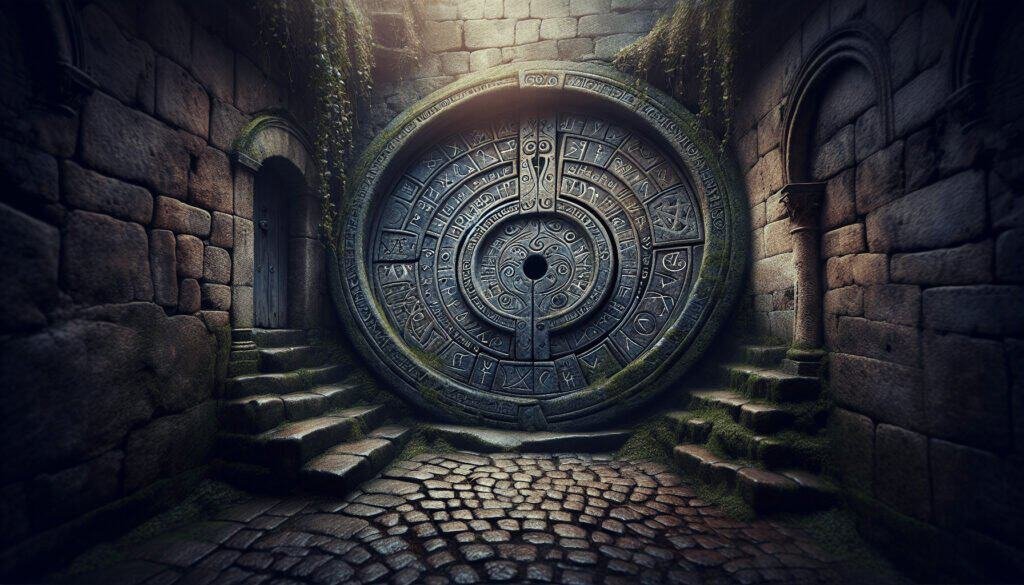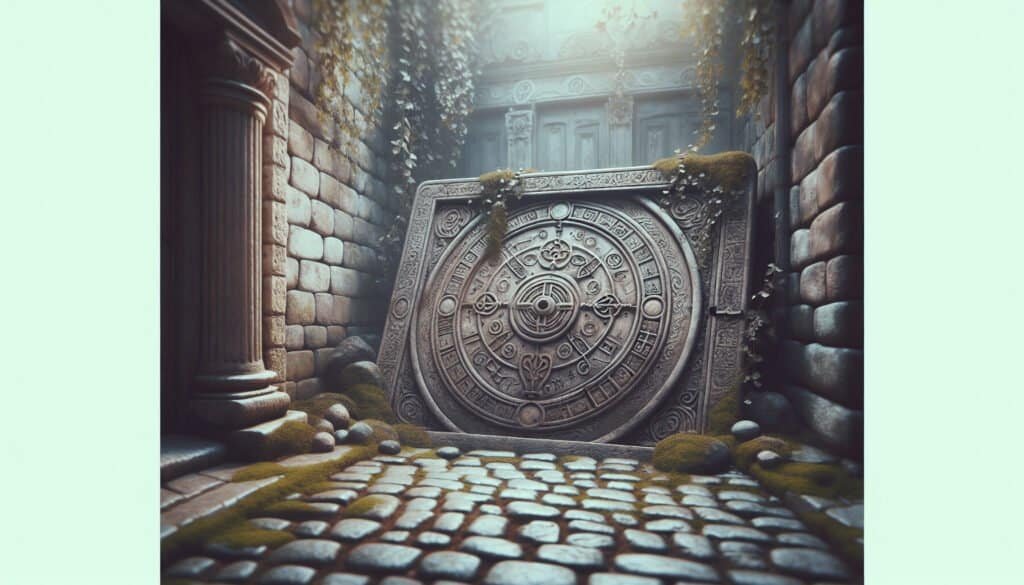Have you ever wondered what mysteries might lie beneath the cobbled streets of ancient cities? One such mystery is the trapdoor in the Old City, shrouded in tales and prophecies that stretch back through centuries. This forgotten entryway connects the present to a deeply rooted past that many believe holds keys to understanding our future. Let’s take a closer look at the Temple Prophecy of Coming Unity and what it means for you and the world around you.
The Old City Trapdoor: A Brief History
Every old city has its secrets, but the Old City is special. Picture this: narrow alleys that echo with whispers of the past, walls that have seen empires rise and fall, and, of course, an enigmatic trapdoor that sparks the imagination. It’s not just an architectural curiosity; it’s a portal to spiritual and historical significance.
The trapdoor poses questions: Why was it built? What lies beneath? Some scholars suggest it once served as a hidden entrance to the Temple, a place of deep spiritual resonance for many. Imagine the stories it could tell if only it could speak.
Archaeological Significance
To truly unravel the narratives woven into the trapdoor’s fabric, you first need to consider the archaeological aspects. Excavations in this area have revealed layers upon layers of history. Each layer offers insights into the way societies used to function and how they viewed the divine.
- Ancient Remains: Some of the foundational stones date back to the First Temple period, around the 10th century BCE.
- Artifacts: Findings include pottery shards, tools, and inscriptions that give context to daily life and worship during biblical times.
The combination of these elements forms a compelling case for the trapdoor’s relevance not only in architecture but also in understanding the ceremonial importance of the Temple.
Religious Context: Understanding the Temple’s Role
The Temple of Jerusalem has been a focal point in Jewish spirituality. It wasn’t just a place for rituals; it symbolized unity among the tribes of Israel. If you’re tuning into this history, getting a grip on how faith and community intertwined will help you grasp the vibrancy of this narrative.
- Sacred Space: The Temple was viewed as the dwelling place of God on Earth. Its destruction and the longing for its restoration captures the essence of communal yearning for unity.
- Temple Prophecies: Various prophetic texts emerge from this milieu, hinting at an eventual gathering of the scattered people, a theme echoed throughout both scripture and tradition.
This motif of unity continues to resonate with contemporary movements advocating for reconciliation across different divides—religious, cultural, and social.
The Prophecy of Coming Unity
What exactly is the Temple Prophecy of Coming Unity? It’s a concept that bridges past and future, suggesting that irrespective of time and space, there exists a divine blueprint aimed at bringing people together.
Scriptural Foundations
The prophecies relating to unity can predominantly be found in the prophetic texts of the Hebrew Bible. Let’s break down a few key passages that depict this vision:
- Isaiah 11:6-9: The imagery of the wolf living with the lamb describes a world where natural enemies coexist harmoniously.
- Zechariah 8:23: This verse talks about nations grasping the skirts of a Jew, driven by a desire to know and connect with the God of Israel—an expression of universal unity.
In essence, these texts seem to affirm that despite the turmoil and division of the past, there exists a hope for a collective coming together—a transformative, divine unifying event.
Modern Interpretations
In today’s world, you might ask how these ancient prophecies translate to contemporary contexts. Surprisingly, the echoes of these prophecies find resonance in modern theology, social movements, and international relations.
- Interfaith Dialogues: Many religious leaders are embracing the universal themes of these prophecies to foster understanding across faiths.
- Cultural Reconciliation: Movements that seek to repair historical injustices and campaign for communal unity strongly reflect the sentiments embedded within these ancient scriptures.
These interpretations illustrate that the Spirit of the prophecy is alive and relevant, pushing people toward shared goals and collective peace.

The Trapdoor as a Symbol
Now, let’s discuss how this Old City trapdoor transcends mere physicality to embody deeper symbolism. It represents both a literal and metaphorical ‘gateway’—an opening to unity and understanding which is especially valuable in times of division.
A Gateway to the Past
Consider this trapdoor as a vital link to your history. It reminds us that to foster unity, we must understand where we come from. Histories—both celebrated and marred—serve as lessons.
- Historical Cycles: Humanity often repeats cycles of division and unity. By reflecting on these cycles, you may find pathways to better futures.
- Inherited Wisdom: There is much wisdom to be gained from understanding past communities’ efforts to unite amidst challenge.
This historical awareness empowers you to engage thoughtfully with contemporary issues, appreciating the complexity while steering toward unity.
A Mark of Hope
Beyond its historical significance, the trapdoor symbolizes hope. Just as it conceals what lies beneath, it holds the potential for discovery and transformation.
- Personal Reflection: You might find that the process of seeking unity requires looking inward. What divisions exist within yourself that you need to address?
- Community Engagement: Think about how you can contribute to unity within your own circles. Small acts of kindness can create impactful ripples.
By not only acknowledging but also embracing the hope the trapdoor represents, we may discover renewed purpose in striving for unity.
The Cinematic Universe of Prophecies
To make sense of ancient texts and their implications in your life isn’t always straightforward. Movies, books, and art often reinterpret these prophecies, bringing them to life in your context.
Film and Literature
Various films and novels explore themes of prophecy and unity, drawing inspiration from ancient texts. The good news is that the messages conveyed aren’t just confined to academia or theological circles. They permeate popular culture in engaging ways.
- Films like “The Matrix”: This classic isn’t just a sci-fi epic; it reflects themes of awakening and finding one’s purpose, reminiscent of prophetic narratives.
- Literary Works: Novels like “The Alchemist” highlight the journey of discovering unity within yourself and the world around you.
These cultural representations guide you through complex discussions of unity, engaging your imagination to probe deeper questions about existence.
Art as Reflection
Don’t overlook the role of art in interpreting prophecies. Artists often grapple with ideas of unity and disunity, using visual language to make you feel and reflect.
- Street Art: Murals that depict unity among diverse communities can be powerful reminders of your capacity to bridge divides.
- Traditional Art: Historical representations of unification found in religious art can inspire you to think about your place in a larger narrative.
Art thus becomes a means of enriching your understanding of ancient wisdom and encouraging a discourse on current themes of companionship and solidarity.

The Trapdoor in Modern Urbanism
Urban planning might seem miles away from ancient secrets, but the lessons learned from the Old City trapdoor have relevance today. You’ve probably noticed how cities are spaces where people from myriad backgrounds mix, often revealing both beauty and conflict.
Lessons in Design
Urban design plays a vital role in fostering unity. As we contemplate the Old City’s trapdoor, ponder how architecture can help or hinder communal bonds.
- Community Spaces: Parks and public squares encourage interactions which can lead to meaningful connections.
- Inclusive Architecture: Designing spaces that consider accessibility can symbolize an openness to inclusivity.
By incorporating these elements, cities can echo the themes of collective unity reminiscent of those ancient prophecies.
A Model for Collaboration
If living in a city often feels like navigating a sea of difference, you can apply lessons from the trapdoor’s symbolism. Collaborating across differences aligns with the essence of unity.
- Interdisciplinary Projects: Engage in community projects that require input from diverse skill sets—art, policy, and science blend beautifully.
- Civic Engagement: Becoming involved in local governance allows you to contribute to more inclusive designs and policies.
Moving forward with collaboration mirrors the prophecy of coming together, as each voice adds a unique touch to the collective.
Implications for Global Unity
Finally, let’s look at the implications of these teachings at a global level. As societies become more interconnected, the call for unity resonates louder than ever in your lives.
Global Movements
From climate change initiatives to humanitarian efforts, waves of global movements share a core message: unity. The trapdoor becomes a metaphor for the collective journey towards addressing pressing global issues.
- Environmental Cooperation: Nations coming together to combat climate change echo the ancient prophecies speaking of a united front in the face of adversity.
- Human Rights: Advocacy for universal rights transcends borders, urging you to uphold the dignity and humanity of every individual.
In your engagement, recognize these movements’ significance and the role you play in supporting collective efforts.
Embracing Diversity
While unity is the goal, diversity is the thread that enriches the tapestry of unified existence. Your unique experiences and insights contribute vibrantly to the shared narrative.
- Celebrate Differences: Engaging with others who hold different perspectives fosters empathy and understanding.
- Intercultural Dialogues: Promote conversations that encourage exchange between varying cultures and beliefs.
In embracing diversity, you pave the way for a more profound sense of unity that honors individuality and promotes collective peace.
In Conclusion: A Modern Interpretation
As you reflect on the Old City trapdoor and the layers of the Temple Prophecy of Coming Unity, consider how these themes continue to shape your existence today.
The connection to your past remains vital. Understanding historical narratives can help you create pathways of unity in an ever-changing world. This trapdoor symbolizes more than just an entrance; it embodies hope, reflection, collaboration, and the call to unite in diversity.
Every step toward unity, whether personal or communal, resonates with ancient wisdom and reminds you uniquely of your role in the grand design of existence. The past doesn’t merely fade; it intertwines with your present, guiding the trajectory toward a harmonious future. Let the trapdoor lead you to the realization that unity is not just a dream but a tangible path worth pursuing.


